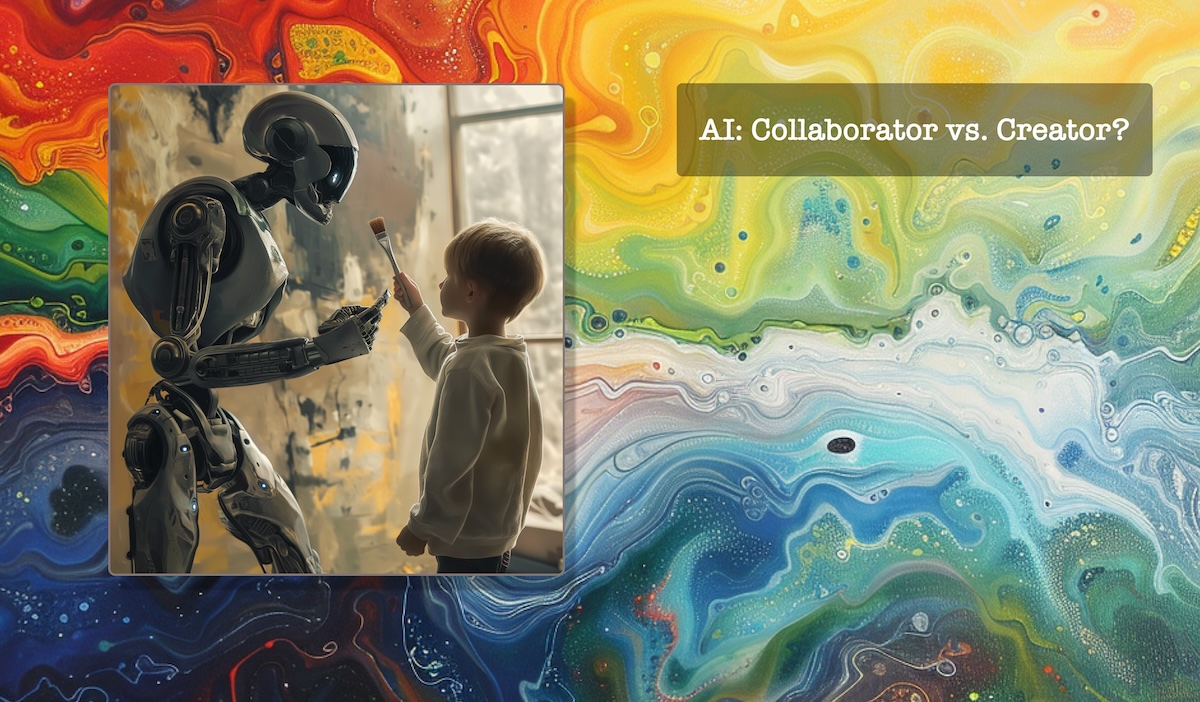Who truly “creates” when we use AI in our art and work?
Let’s put aside two of the top discussion topics around AI today which seem to be sucking up all the air (existential risk of AI killing humanity and AI replacing human jobs and labor) and start by asking ourselves some really hard questions as it relates to AI, authenticity, and creativity.
AI Disclosures?
As AI becomes increasingly integrated into our creative processes, it raises important questions about transparency and authorship:
- When we create something, should we be disclosing whether AI was included? Or should we just stealthily act as if we did it all?
- Furthermore, did AI have a role as a contributor, researcher, collaborator or something else?
- Should we be sharing that with our viewers and readers? Why or why not?
AI as a Variable Use Collaboration Tool?
These AI tools can be used in a myriad number of ways. AI can automate entire processes, i.e. “Write me a book on X,” “Create a Picasso Painting,” etc.). It could alternatively be applied tactically and judiciously at certain stages and creative points (i.e. research, ideation or revision). It’s worth asking:
- How can and should we as creatives, artists and knowledge workers be using these AI-powered tools like ChatGPT?
- What role do we want it to play in our work?
- Where can and should AI tools fit in your creative process?
Authenticity of AI-Assisted Creations?
- Is using AI to create “authentic”?
- If we all agree that using AI to write a complete essay is “cheating” and completely inauthentic (meaning “100% Not You”), what about using AI in a partial role?
- If I merely use it to help ideate, research, outline, or correct basic grammar, spelling or clarify mistakes, is that cheating or inauthentic?
- What about having it generate a few paragraphs here and there?
- What’s the line between authenticity and inauthenticity when it comes to creating art with AI?
Put practically, as a creative or knowledge worker, what does it mean or should it mean to be authentic and still be using AI tools?
Some Thoughts
There are no obvious answers to these questions, both personally and societally. Authenticity is a tricky topic on its own and now we must ponder the role of the tools have in helping us enact and bring from our minds things and art into the world.
I’ll admit that I use ChatGPT regularly. I use it to help me to do my day job (as a software product builder) better and in less time. I use it as a journaling companion and to prompt reflection, leading me to re-think processes or even alter my decision making. I also use AI image generators like Midjourney and DALL-E to help me create blog covers and graphics for what I write.
While I use AI on parts of my creative and productive process, I don’t use AI tools to fully write or create for me. I believe this distinction is key. It’s incredible what A.I. tools can do end-to-end, but as an artist, I personally don’t want to remove all from what is the essentially “human” and “creative” from my creative process.
This idea stems from preserving your role as driver of an artistic creation and figuring out how to complement your role as creator with AI as a co-creator and collaborator. I recently gave a speech on AI and Creative Empowerment called From Reflection to Composition and Beyond: Empowering Creative Musical Minds with AI Tools where in the context of generative music AI tools, I explored this in depth.
Editing and revising are tedious and hard. Research and ideation are better with knowledgeable collaborators. It is useful and time-saving to have AI and tech help at certain steps and in specific workflows. I often lean into automation and process improvements. Outside of a certain desire to preseve old traditions, like making hand-made clothes or otherwise, anything we can do to improve our productivity and output can and should be considered. Recent AI tools are empowering, because they give us more time to think and be creative. There are various steps in the learning and creative process that are significantly easier with these new AI tools.
But if we let an AI tool do it all, are we the creator at all? And what is the cost of removing yourself from whatever is your most creative component in that creative process? Are you even the creator anymore or just the dictator of a tool’s creative enactment?
If we take the role of AI seriously in the next evolution of humanity, then it’s time to start reflecting and “owning” how we are using AI to think, create and do. I’m all in on using AI and technology to enable and empower the human, which you can see in my AI-enhanced journaling experience, Stay Reflective. But I recognize the need to start defining new social norms around AI in creation and distribution. For example, when and if you use AI in your work, it’s probably necessary, I believe, like academic citations, to disclose the role of AI in our work, which is a topic for another post.
Even if I use AI to automate and augment, for me it’s essential to preserve my creative parts and strive find genuine yet variable uses for AI in my creative process all while maintaining my place as the primary actor in my creative manifestations.
AIDA (AI Disclosure Acknowledgement): This post was written entirely by me. I leveraged an AI system (ChatGPT-4) for editing, minor revisions and improved clarity. I used an AI system (Midjourney) to generate visual elements which I edited and refined.

